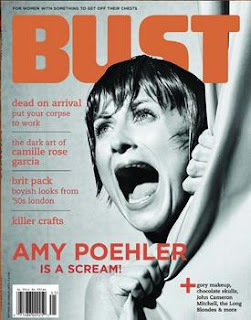"That women are acutely under-represented in ownership is part of the larger crisis of representation and participation in the media overall.” - Carol Jenkins: President, The Women's Media Center
It is well known that the media carries influence of epic proportions. That being said, the ways in which the media typically chooses to exert this power are disturbing. While women compose 51% of the United States population, only a quarter of the available jobs in the media/communications field were filled by women between 1990 and 2005. Only 6% of commercial broadcast television stations and only 6% of commercial broadcast radio stations in the United States are owned by females (http://www.now.org/issues/media/women_in_media_facts.html). If women are not fairly represented, it is safe to say that the issues women truly want and need the media to focus on will not be showcased.
One example of an alternative media source that is geared toward women is the American BUST magazine. As their website (http://www.bust.com/) states, “With an attitude that is fierce, funny, and proud to be female, BUST provides an uncensored view on the female experience. BUST tells the truth about women's lives and presents a female perspective on pop culture. BUSTing stereotypes about women since 1993.” Founded by Debbie Stoller, Laurie Henzel, and Marcelle Karp, Bust prides itself on showcasing issues such as yes, sex and fashion, but also current events, music and art from a feminist point of view. Stoller, the current editor-in-chief, is said to have chosen the name “BUST” because it coincided with the idea of women busting through gender stereotypes, and because the name could also be used as a title for a men’s pornographic magazine.
Another example of an independent magazine aimed at women is the Canadian Cahoots, created in 2005 by Carla Atherton and Michele Rowe. After noticing the obvious lack of true female representation in mainstream media, the women wanted to create an outlet for intelligent, cultured women. The typical issue focuses on topics relating to females’ careers, homes, and lives, as well as the arts, including fiction writings and poetry.
While these are both great sources for women, it is also extremely important that similar alternative sources exist for the adolescent demographic. As Barbara Wiener states in her article, “Highlighting Girls in Youth Media” (http://www.youthmediareporter.orCg/2009/08/highlighting_girls_in_youth_me.html),” If youth media organizations can highlight girls’ developmental skills with gender specific programs, we can help girls construct images and stories that reveal their unique voices. As youth media organizations nurture and share girls’ work, we are able to influence the mainstream media idea of gender roles, which impact all of us within and outside of the field. As a girl sees her work in public, she becomes more powerful, her perspectives matter, and the effect ripples throughout her life and society. All youth media programs can help expand girls’ leadership and experience of cultivating and showcasing their ideas. We have an opportunity to develop half the world’s population—where girls lead the way.”


No comments:
Post a Comment